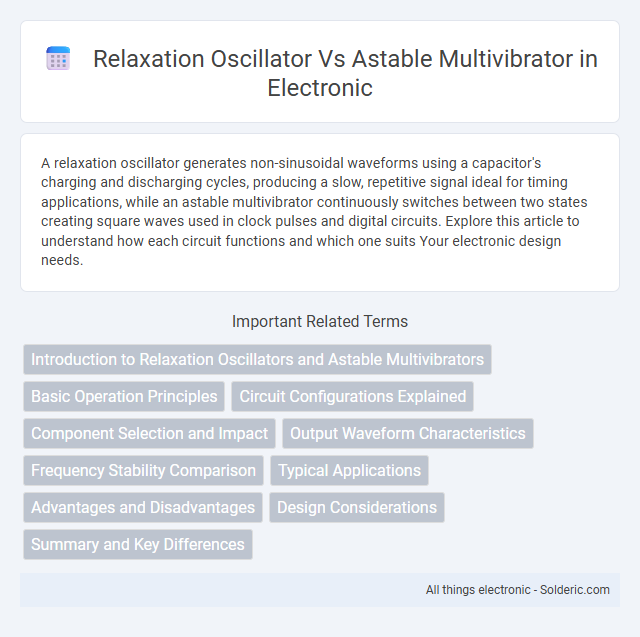A relaxation oscillator generates non-sinusoidal waveforms using a capacitor's charging and discharging cycles, producing a slow, repetitive signal ideal for timing applications, while an astable multivibrator continuously switches between two states creating square waves used in clock pulses and digital circuits. Explore this article to understand how each circuit functions and which one suits Your electronic design needs.
Comparison Table
| Feature | Relaxation Oscillator | Astable Multivibrator |
|---|---|---|
| Operation Principle | Charges and discharges a capacitor through a resistor to create oscillations | Uses two active devices switching states alternately without a stable state |
| Waveform Output | Typically generates a sawtooth or triangular wave | Generates a square wave output |
| Components | Usually one active device, resistor, and capacitor | Two transistors and coupling capacitors |
| Frequency Control | Set by RC time constant (R and C values) | Determined by resistors and capacitors in feedback network |
| Applications | Timing circuits, pulse generators, function generators | Clock pulses, LED flashers, pulse generation |
| Stability | Less stable, frequency affected by component tolerances | More stable due to symmetrical switching |
Introduction to Relaxation Oscillators and Astable Multivibrators
Relaxation oscillators and astable multivibrators are fundamental electronic circuits used to generate periodic waveforms without requiring an external input signal. Relaxation oscillators rely on the charging and discharging of capacitors through resistive elements to produce non-sinusoidal waveforms like sawtooth or square waves, essential in timing and waveform generation applications. Your choice between these oscillators depends on the required frequency stability and waveform shape for circuits such as pulse generators, flashing lights, or timing devices.
Basic Operation Principles
A relaxation oscillator generates non-sinusoidal waveforms by charging and discharging a capacitor through a resistor, causing the circuit to switch states when a threshold voltage is reached. An astable multivibrator continuously oscillates between two unstable states, producing a square wave without requiring an external trigger. Understanding these basic operation principles helps you select the appropriate oscillator type for timing, waveform generation, or signal modulation applications.
Circuit Configurations Explained
Relaxation oscillators typically use a single reactive component such as a capacitor or inductor combined with a nonlinear switching device like a unijunction transistor or comparator to generate a periodic waveform through charging and discharging cycles. Astable multivibrators rely on two amplifying devices, commonly transistors or operational amplifiers, configured with cross-coupled feedback loops and timing resistors and capacitors to produce continuous square wave oscillations without any stable state. Understanding these circuit configurations helps you select the most suitable oscillator type based on waveform shape, frequency stability, and component availability for your electronic design needs.
Component Selection and Impact
Relaxation oscillators primarily use a resistor-capacitor (RC) network along with a unijunction transistor or operational amplifier, where component values directly influence frequency stability and waveform shape. Astable multivibrators typically rely on a pair of transistors, capacitors, and resistors, with transistor switching times and resistor-capacitor combinations determining oscillation frequency and duty cycle. Component tolerances and temperature coefficients critically affect both circuits' performance, but astable multivibrators offer more precise frequency control due to symmetrical transistor switching characteristics.
Output Waveform Characteristics
Relaxation oscillators produce non-sinusoidal waveforms such as sawtooth or triangular signals, characterized by slow charge and rapid discharge cycles, resulting in asymmetrical waveforms. Astable multivibrators generate continuous square wave outputs with equal high and low time intervals, providing a stable frequency and duty cycle determined by resistor-capacitor (RC) components. The relaxation oscillator's waveform exhibits varying slope and amplitude, while the astable multivibrator offers clean, symmetrical pulses ideal for clock and timing applications.
Frequency Stability Comparison
Relaxation oscillators typically exhibit lower frequency stability due to their reliance on nonlinear elements and charging-discharging cycles, which are sensitive to component variations and temperature changes. In contrast, astable multivibrators provide better frequency stability by utilizing more consistent feedback and switching mechanisms, often benefiting from symmetrical transistor pairs or integrated circuit configurations. The frequency of an astable multivibrator is less prone to drift, making it more suitable for applications requiring precise timing.
Typical Applications
Relaxation oscillators are commonly used in low-frequency timing circuits, light flashers, and tone generators due to their simple design and ease of frequency adjustment. Astable multivibrators find typical applications in clock pulse generation, square wave generation for digital circuits, and LED or lamp blinking circuits where a stable oscillation frequency is crucial. Both circuits serve essential roles in signal generation, with relaxation oscillators favoring simplicity and astable multivibrators providing more precise control over frequency and waveform stability.
Advantages and Disadvantages
Relaxation oscillators offer simplicity and generate non-sinusoidal waveforms ideal for timing circuits but suffer from lower frequency stability and higher harmonic distortion. Astable multivibrators provide stable square wave outputs with adjustable frequency and duty cycle, making them suitable for clock generation, yet they typically consume more power and produce more switching noise. Selecting between these oscillators depends on the application's requirements for waveform purity, power consumption, and frequency precision.
Design Considerations
Relaxation oscillators require careful selection of resistive and capacitive components to control the charging time constant, ensuring stable frequency output and waveform shape, often favoring simplicity over precision. Astable multivibrators demand symmetric transistor configurations with matched gain and timing components to achieve consistent duty cycles and oscillation frequencies, emphasizing transistor switching characteristics and power consumption. Design considerations for both circuits must address temperature stability, component tolerances, and load effects to maintain reliable oscillation performance.
Summary and Key Differences
Relaxation oscillators generate non-sinusoidal waveforms using a capacitor charging and discharging through a resistor, producing a variable frequency based on component values. Astable multivibrators create continuous square wave oscillations with two active states, relying on transistor or logic gate switching for stable frequency output. Key differences include waveform shape--relaxation oscillators yield sawtooth or triangular waves, while astable multivibrators produce square waves--and circuit complexity, with astable multivibrators typically involving bistable switching elements for precision timing.
Relaxation oscillator vs Astable multivibrator Infographic

 solderic.com
solderic.com